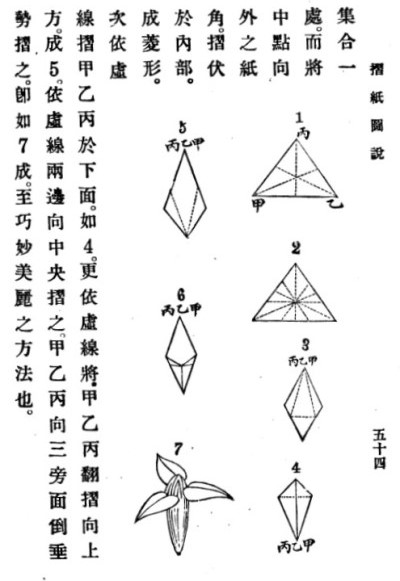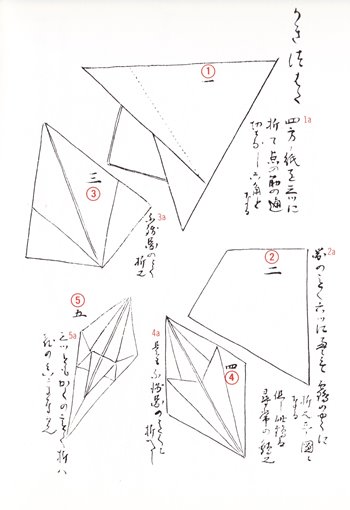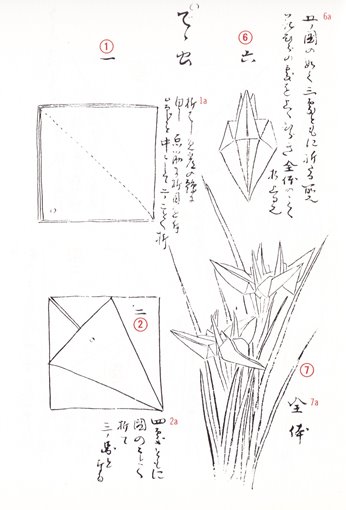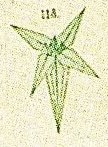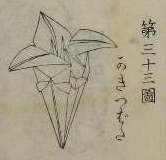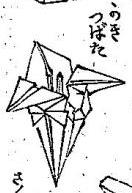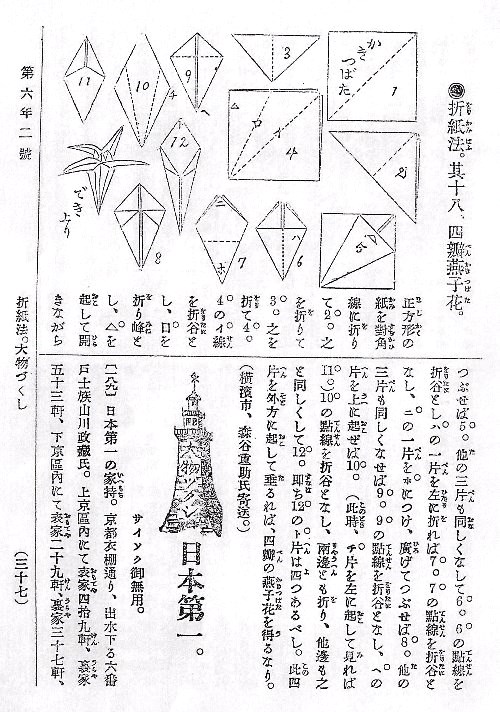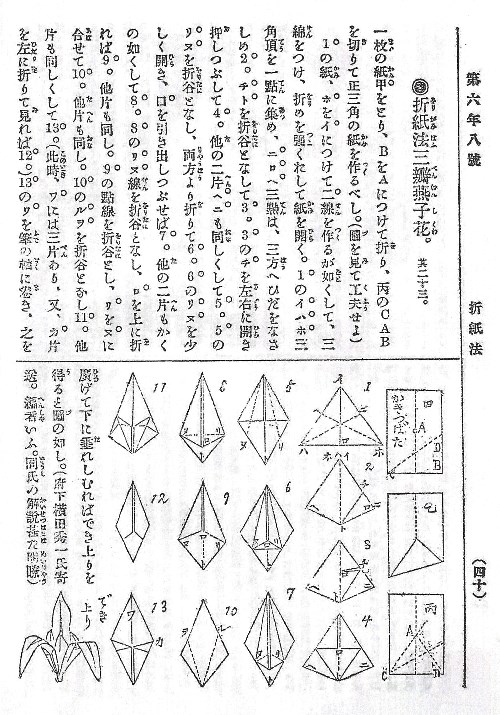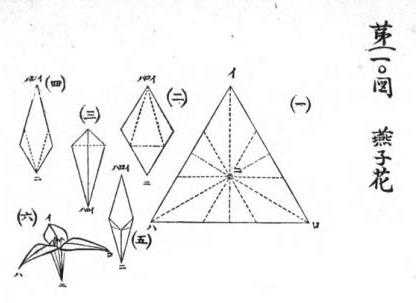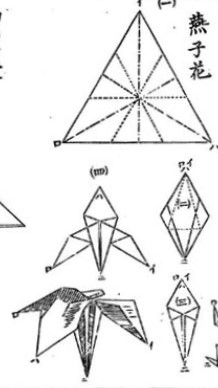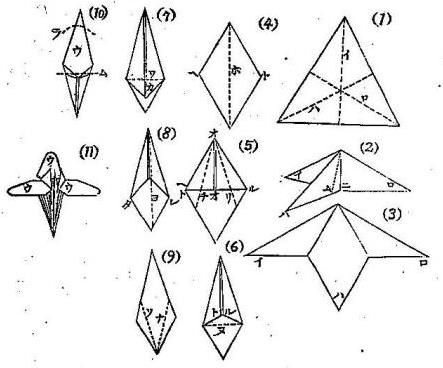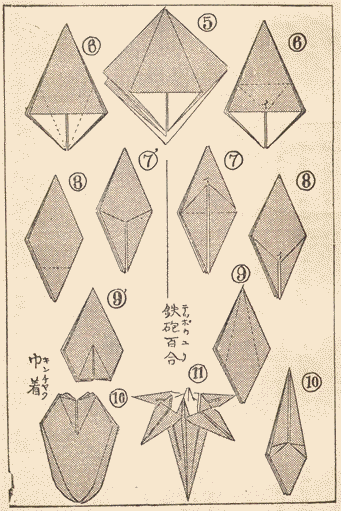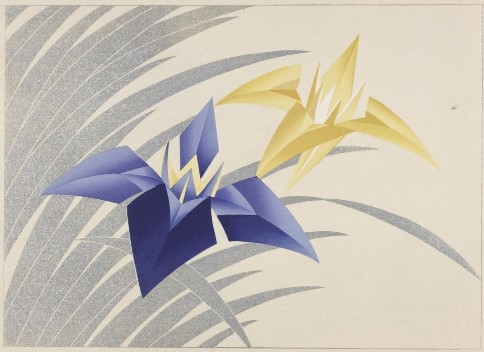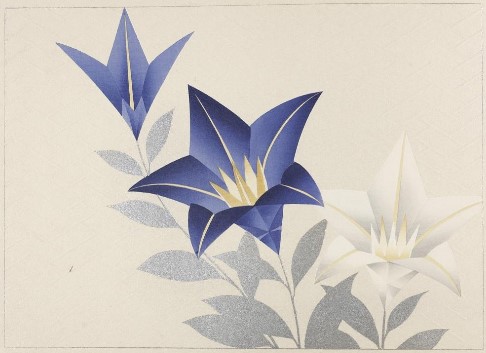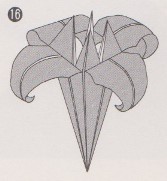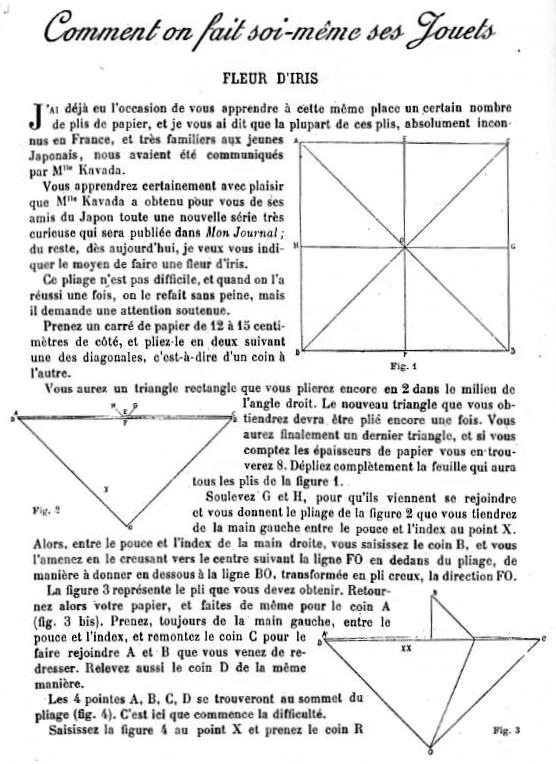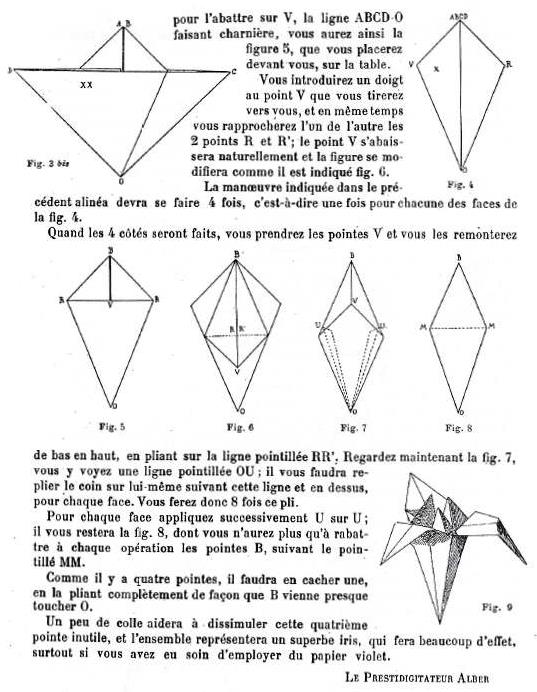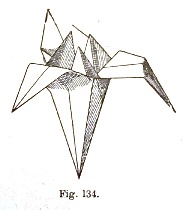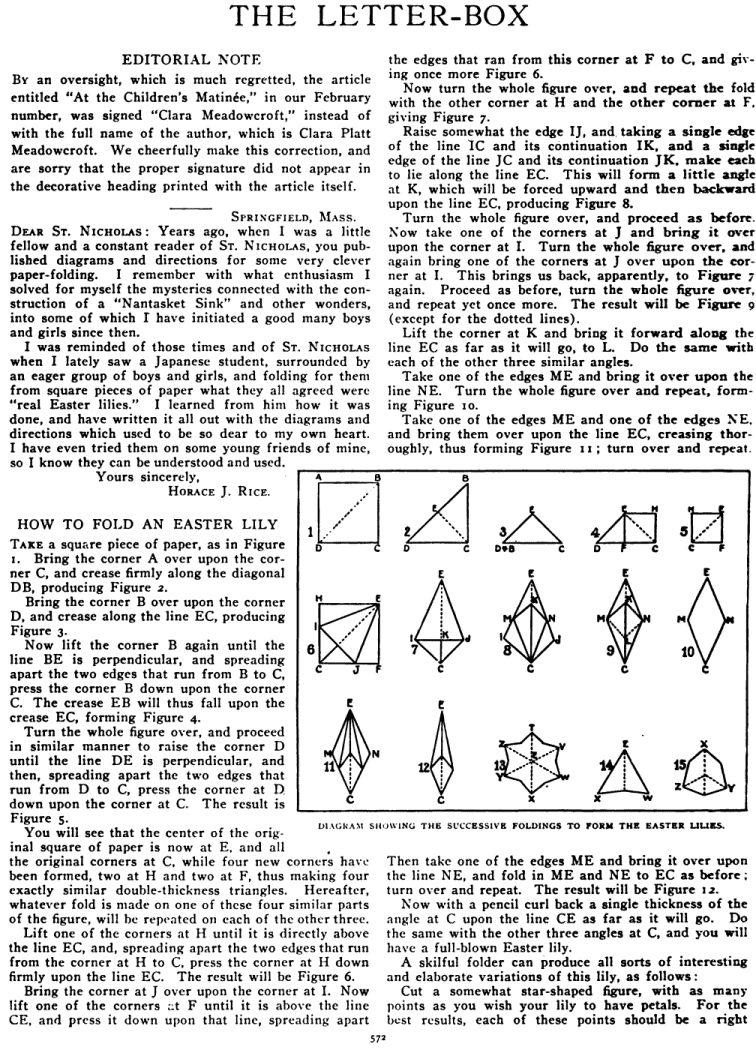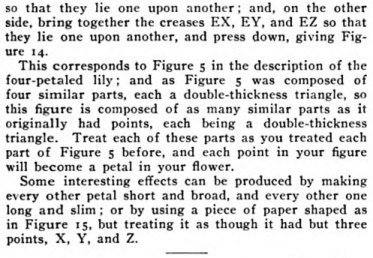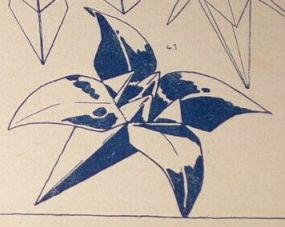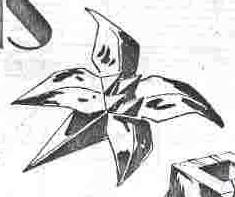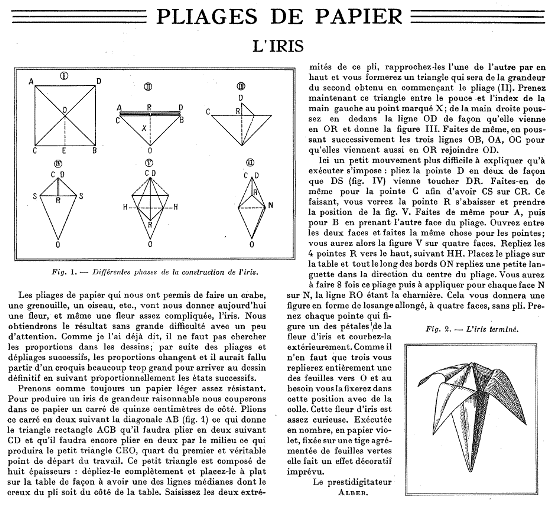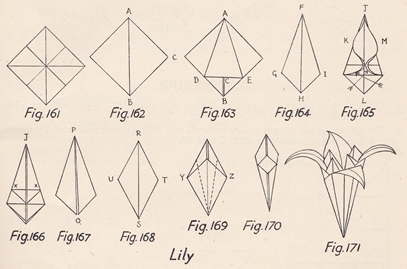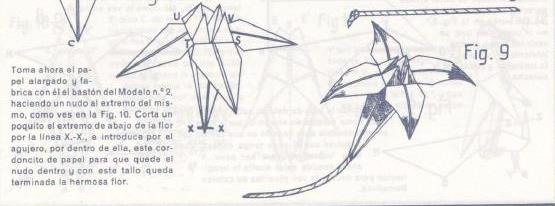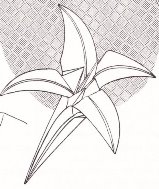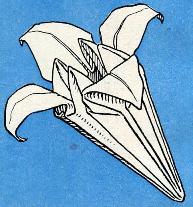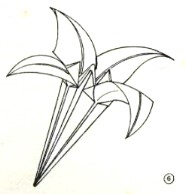| The Public Paperfolding History Project
x |
|||||||
| The Lily/ Iris / Bellflower | |||||||
| This
page is being used to record information about the
history of the origami designs known as the Iris, the
Lily and the Bellflower, the Iris having three petals,
the Lily four and the Bellflower five. The fundamental
folding method is the same for all the designs although
the starting shapes differ. Please contact me if you know
any of this information is incorrect or if you have any
other information that should be added. Thank you. The Iris can be folded from a hexagon or an equilateral triangle. The Lily is folded from a square and the Bellflower from a five-pointed star. Other variations are possible. I have included all the variations in a single chronology. ********** In China (and in publications by Chinese authors) 1914 'Zhe zhi tu shuo' (Illustrated Paperfolding), compiled by Gui Shaolie, which was published by the Commercial Press in Shanghai in Ming guo 3 (1914), includes diagrams for a four-petalled version, titled 'Swallow Flower' and a five-petalled version, titled 'Bellflower'.
********** In Japan (and in publications by Japanese authors) 1845 The earliest illustration of / diagrams for this design that I know of appear in the Kan No Mado, which is usually dated to 1845. The instructions on the left begin from a hexagon and those on the right from a square.
********** 1878 The earliest illustration of the Lily that I know of appears in 'Yochien Ombutsu No Zu', a publication of kindergarten material issued by the Tokyo Women's Normal School in 1878.
********** 1885 A drawing of the Iris appeared in 'Kindergarten Shoho' (Preliminary Kindergarten) by Iijima Hanjuro, which was copyrighted on October 4th Meiji 17 (1884) and published by Fukuda Senzo in August of Meiji 18 (1885).
********** 1892 A drawing of the Iris also appears in 'Kani Shukogaku' (Simple Handicraft) by Tamotsu Shibue, which was published in Tokyo in 1892.
********** 1894 The Lily appears as 'Kakitsubata' (Swallow Flower) in issue 2 of the children's magazine 'Shokokumin' for the year 1894.
********** The Iris (folded from an equilateral triangle) appears in issue 6 of the children's magazine 'Shokokumin' for the year 1894.
********** 1903 Diagrams for the Iris appear in 'Jinjo Kouto Shogaku Shuko Seisakuzu' (Handicrafts for ordinary higher elementary schools) by Hideyoshi Okayama, which was published by Rokushiro Uehara in Tokyo in 1903.
********** 1905 Diagrams for a version of the Iris folded from an equilateral triangle appear in 'Shukouka Kyohon : Liron Jishuu Souga Setsumei' by Kikujiro Kiuchi, Rokushiro Uehara and Hideyoshi Okayama, which was published by Shigebei Takase in Chiba in 1905.
********** A drawing of the Iris design also appears in 'Shukoka Kyoju Saian' by Gentaro Tanahashi and Hideyoshi Okayama, which was published by Hobunkan in Tokyo in 1905.
********** 1907 Diagrams for the Iris appear in 'Shukou Tebikigusa : Kokumin Kyoiku Origami Yuihimo' by Ishin Nishigaki, which was published by Meguro Shoten in Nagaoka in 1907.
********** 1908 Diagrams for the Iris also appear in 'Origami zusetsu' (Illustrated Origami) by Sano Shozo, which was published in Tokyo in 1908.
********** 1931 Diagrams for the Lily appears in 'Origami (Part 1)' by Isao Honda, which was published in Japan in 1931.
********** 1935 'Origami Moyo, Book One', by Kawarazaki Kodo, which was published by Unsodo in Japan in 1935, contained a print titled 'ayame' (which means 'iris') showing the Lily and a second print titled 'kikyou' (which means 'bellflower').
********** 1965 The Lily also appears in 'The World of Origami' by Isao Honda, which was published in the USA by Japan Publications Trading Company in 1965.
********** In Western Europe and the Americas 1900 A three-petalled design, called 'Fleur d'Iris' and folded from a square, appears in an article by Alber-Graves in the French children's magazine 'Mon Journal', probably in 1900, although I have not been able to identify the exact date of the article. The introduction says, roughly, 'I have already had the opportunity to teach you how to make a number of paperfolds, and I told you that most of these folds, absolutely unknown in France, but very familiar to young Japanese, had been communicated to us by Mlle Kavada. You will certainly be pleased to learn that Mlle Kavada has obtained for you from her friends in Japan a whole new, very curious, series which will be published in Mon Journal; today I want to show you how to make an Iris flower.'
********** 1908 The same diagrams appear in 'Les Petits Secrets Amusants' by Alber-Graves, which was published by Librairie Hachette in Paris in 1908.
********** 1914 The four-petalled Lily design appears in the American children's magazine St Nicholas, volume 41 part 1 of November 1913 to April 1914 in a letter to the editor by Horace J Rice. (Information from Oschene.) It is noteworthy that the letter-writer mentions learning it from 'a Japanese student'. The letter also explains how to make a six-petalled variation. The 'Nantasket Sink' referred to in the opening paragraph of the letter is a misremembering of 'Nantucket Sink', a design which had appeared in the issue of St Nicholas for August 1887, and which turns out to be an alternative name for the Sanbo On Legs.
********** 1932 The four-petalled Lily appears, though as 'La Fleur D'Iris', in Booklet 4 of 'Images A Plier' (the fourth of a series of 6 booklets intended for school teachers) published in 1932 in Paris by Librairie Larousse.
********** The design also appears: As 'un Iris', in Booklet 3 of 'Figuras de Papel', a series of 3 booklets published by B Bauza in Barcelona in 1932.
********** 1934 In 'La Nature' Issue 2940 of 1st November 1934 in an article by Alber headed 'Pliage de papiers' and subheaded 'L'iris'.
********** 1937 As 'Lily' in Margaret Campbell's 'Paper Toy Making', which was first published by Sir Isaac Pitman and Sons Ltd in London, probably in 1937, although both the Foreword and Preface are dated 1936, which argues that the book was complete at that date.
********** 1951 In the extended version of 'El Mundo de Papel' by Dr Nemesio Montero, which was published by G Miranda in Edicions Infancia in Valladolid in 1951, as 'La Flor'.
********** 1964 In 'Secrets of Origami', by Robert Harbin, which was published by Oldbourne Book Company in London in 1964, where it is said to be Japanese.
********** 1968 In the 1968 Rupert Annual as 'How to Make A Paper Lily'
********** In 'Your Book of Paperfolding' by Vanessa and Eric de Maré, which was published by Faber and Faber in London in 1968, where it was is to be a traditional Japanese design.
********** |
|||||||
